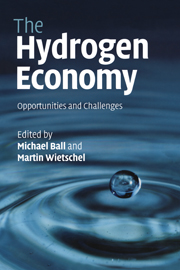Book contents
- Frontmatter
- Contents
- List of main contributors
- Preface
- Acknowledgements
- List of abbreviations
- 1 Scope of the book
- 2 Why hydrogen?
- 3 Non-renewable energy resources: fossil fuels – supply and future availability
- 4 Non-renewable energy resources: nuclear fuels
- 5 Assessment of the potentials for renewable energy sources
- 6 Carbon capture and storage
- 7 Energy-chain analysis of hydrogen and its competing alternative fuels for transport
- 8 Hydrogen today
- 9 Fundamental properties of hydrogen
- 10 Hydrogen production
- 11 Hydrogen storage
- 12 Hydrogen distribution
- 13 Key role of fuel cells
- 14 Hydrogen-infrastructure build-up in Europe
- 15 Building a hydrogen infrastructure in the USA
- 16 Hydrogen and the electricity sector
- 17 Hydrogen corridors
- 18 Macroeconomic impacts of hydrogen
- 19 Sustainable transport visions: the role of hydrogen and fuel-cell vehicle technologies
- 20 Energy-efficient solutions needed – paving the way for hydrogen
- 21 The future of hydrogen – opportunities and challenges
- Further reading
- Index
- References
18 - Macroeconomic impacts of hydrogen
Published online by Cambridge University Press: 22 January 2010
- Frontmatter
- Contents
- List of main contributors
- Preface
- Acknowledgements
- List of abbreviations
- 1 Scope of the book
- 2 Why hydrogen?
- 3 Non-renewable energy resources: fossil fuels – supply and future availability
- 4 Non-renewable energy resources: nuclear fuels
- 5 Assessment of the potentials for renewable energy sources
- 6 Carbon capture and storage
- 7 Energy-chain analysis of hydrogen and its competing alternative fuels for transport
- 8 Hydrogen today
- 9 Fundamental properties of hydrogen
- 10 Hydrogen production
- 11 Hydrogen storage
- 12 Hydrogen distribution
- 13 Key role of fuel cells
- 14 Hydrogen-infrastructure build-up in Europe
- 15 Building a hydrogen infrastructure in the USA
- 16 Hydrogen and the electricity sector
- 17 Hydrogen corridors
- 18 Macroeconomic impacts of hydrogen
- 19 Sustainable transport visions: the role of hydrogen and fuel-cell vehicle technologies
- 20 Energy-efficient solutions needed – paving the way for hydrogen
- 21 The future of hydrogen – opportunities and challenges
- Further reading
- Index
- References
Summary
Often only technical aspects are considered when looking at hydrogen as an energy carrier. However, the introduction of hydrogen could have relevant implications for GDP, welfare and job developments in a nation or region. The competitiveness of a nation could be one major driver for hydrogen use as an energy carrier. These issues are discussed in the following. Among other things, possible economic effects are shown on the basis of a quantitative model analysis and assessed for relevant EU member states.
Introduction
A lot of research in the hydrogen and fuel-cell field has a strong technology focus (e.g., technology research, application of technologies, technology roadmap and infrastructure build-up). The analysis of economic impacts tends to concentrate on the necessary investments for hydrogen infrastructure build-up (see Chapters 14 and 15). Other very important impacts of hydrogen as an energy fuel, such as those on employment, gross domestic product (GDP), international competitiveness or welfare, are often mentioned as important benefits of a hydrogen use as an energy vector but they are usually not well analysed.
For such kinds of analysis, four different methodological approaches are normally used for analysis in the energy sector: input–output, general equilibrium, system dynamics and econometric models.
Such kinds of model, emphasising an aggregate description of the overall economy, are general economic models with a rather rudimentary treatment of the energy system. Following the top-down approach, they describe the energy system (similar to the other sectors) in a highly aggregated way.
- Type
- Chapter
- Information
- The Hydrogen EconomyOpportunities and Challenges, pp. 529 - 562Publisher: Cambridge University PressPrint publication year: 2009



